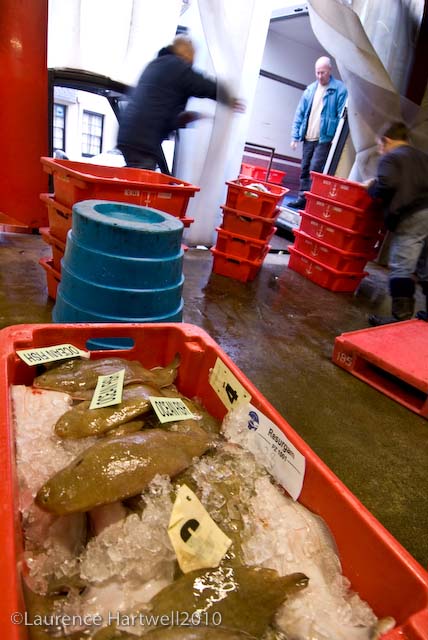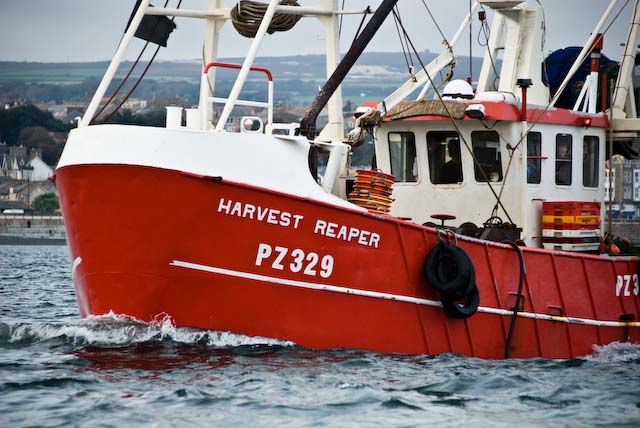If those proposals are accepted by the Council of Ministers on 16th December, it can only mean one thing - that the kind of casualties already seen in the Bristol Channel this year will be visited upon other inshore fleets in 2015.
 |
| Dover soles form a huge part of the landings in Newlyn - skippers are currently reporting Dover soles everywhere they fish - and are dumping them as they have no quota even now. |
The scale of the proposed reductions are breathtaking, including: A 60% reduction in the TAC for eastern Channel sole, a stock of central importance to the inshore fleet
- A 64% cut in the TAC for Celtic Sea cod, which will impact on a wide range of fleets including the under-10s
- Bristol Channel sole cut by 35%, when the existing quota was exhausted by June of this year
- Haddock in the Celtic Sea cut by 41%; another stock fished by a wide range of vessel sizes
- Skates and Rays in the North Sea and Western Waters face a further cut of 20%
If these proposed cuts had taken place against the background of a crisis in the stocks, it might have been plausible to argue that this very severe medicine is necessary to counter extreme overfishing. But they take place against the background of greatly reduced fishing pressure and a generally improving biomass for the stocks in our waters. These are not cuts driven by scientific stock assessments which indicate a serious problem with stocks. They are driven exclusively by a political agenda which forces an MSY timetable on decision-makers; along with a brutal approach to any fishery deemed to have insufficient data.
 |
| Mitch Tonks' recipe for ray wings will soon become a luxury dish as fish shops rely on imported fish - no doubt caught in UK waters by other EU boats with bigger quotas! |
There is a direct contradiction between concerns expressed by a range of green organisations for notional small-scale fisheries and the lobbying activities of those same organisations at European level for an “ambitious” MSY timetable, which could well lead to the demise of a range of actual small-scale fisheries.
The scale of the proposed quota reductions, against the background of increasing abundance of fish stocks experienced on the grounds, could lead one to forgive those predisposed to conspiracy theories. But despite appearances, this is not a plot to eliminate the small-scale fisheries around our coasts. It is primarily the result of a blundering political decision, enshrined in law in the new CFP, to force ministers to set TACs according to a rigid timetable – MSY by 2015, or 2020 at the latest. Scientists, officials, ministers and, of course fishermen and fish workers, are now tied into a legal framework with very little room to manoeuvre. That was exactly the intention of enshrining MSY – a political concept masquerading as science – as a mandatory part of the new CFP.
 |
| Harvest Reaper PZ329 is typical of many day hauling Under 10m vessels in the South West landing top quality fish. |
For those who think that we are crying wolf, and don't have the imagination to envisage the consequences of this scale of quota reductions, it is only necessary to look at the experience of the Bristol Channel this year: quotas so small, following cumulative reductions, as to become unmanageable; fleets displaced from the Bristol Channel; under-10m vessels tied up; the main fish processor closed; fish workers who have lost their jobs. This can only be the fate of other fisheries if these reductions are accepted.
Alternative Path
Since 2000, fishing mortality has been dramatically reduced across the North East Atlantic by around 50%. Stocks are rebuilding; some rapidly; some more slowly, depending on local and ecosystem factors. A rational, balanced and proportionate fisheries management approach would aim to continue this steady climb towards high-yield fisheries, without bankrupting the fleets. Even within the rigid CFP framework, ministers do have some scope to balance out the more extreme effects of the MSY timetable by setting TACs at a level commensurate with the viability of the fleets; and avoiding the unacceptable human costs of a repeat of the Bristol Channel catastrophe.
This will take political courage - to face down those in the green lobby and their friends in the media, apparently oblivious to the human costs of the policies they have largely been responsible for. It will take international cooperation – ministers will have to work together to avoid being isolated and picked off by concessions here and there. It will take a deeper understanding of the consequences of cumulative TAC reductions on fishing businesses and fishing communities. It will also take the intervention of the new Commissioner to ameliorate the dogmatic and damaging policies of his predecessor.
Courtesy of the NFFO



























